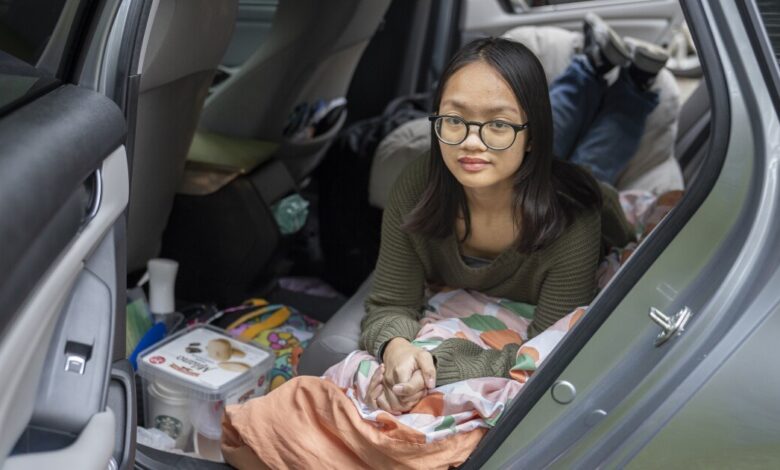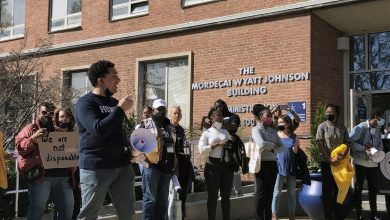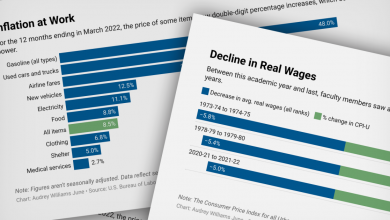When There’s Nowhere to Live, What’s a University to Do?

She squeezed her pared-down wardrobe into two small boxes, which fit in the trunk. School supplies and some packaged food went in the passenger seat. The back seat became her bed.
Quijano, a biology major at the University of California at Santa Cruz, had hoped to win a coveted spot on campus, but she didn’t get one before classes began.
UC-Santa Cruz has enough campus housing for about half of its 18,000 undergraduates. That’s a lot; in fact, the university houses more students than any other UC campus. But Santa Cruz faces a challenge: Housing stock off campus is almost nonexistent and extremely expensive. Most residences are single-family homes with independent landlords, many of whom are hesitant to rent to students.
On campus, housing priority is given to freshmen, new transfers, and sophomores, in that order, as well as first-generation students from California, military veterans, and international students. Even then, there’s no guarantee.

LiPo Ching for The Chronicle
So Quijano started the 2022 fall term living in her car.
It’s not that university leaders oppose building more student housing. They can’t — at least not easily.
The topography of the Santa Cruz campus — carved into the side of a mountain, surrounded by a protected forest — means there’s almost nowhere to build. When university officials find land on campus and make a plan, they get sued by local residents who fear the impacts of growth. The court fights drag on for years. Meanwhile, the University of California’s Board of Regents wants the system’s campuses to enroll even more students, citing high demand for a UC education.
Across the country, colleges struggle with housing shortages from time to time, and administrators make contingency plans. What’s happening at Santa Cruz, though, isn’t a one-time crunch. It’s a systemic, structural logjam with no clear way out.
University leaders say they’re committed to easing the strain, pushing ahead on construction projects that will take years to complete. In the meantime, many Santa Cruz students must shoulder the immense stress of trying to get through college without having their basic needs met.
Their housemate who dropped out for a quarter to save money for rent; their friends who commute 35 miles from San Jose every day, up and down the notoriously hazardous narrow shoulders and tight turns of Highway 17; the guy in their econ class who rents a driveway so he can live safely in his car for $500 a month.
Most students will also tell you that they didn’t know just how hard it would be to find housing until they arrived.
Homelessness and housing insecurity are longstanding problems in Santa Cruz, a beach town nestled between the central coast and the redwood-forested Santa Cruz mountains that consistently ranks among the most unaffordable places in the country to live.
The UCSC sociology professors Miriam Greenberg and Steven McKay surveyed Santa Cruz County residents between 2016 and 2018, and found that 50 percent of 1,737 respondents spent over half of their income on rent. The government defines that threshold as “extremely rent burdened.” The researchers then had to invent a new category, “obscenely rent burdened,” for the 26 percent of respondents who said they spent at least 70 percent of their income on rent.
Then the pandemic hit. Newly remote tech workers moved in. The median price of a single-family home skyrocketed, as did rents. Off-campus houses that had historically been rented to students were bought up and converted into owner-occupied housing.
The squeeze became untenable — and further complicated an already complicated relationship between Santa Cruz and its largest employer, the university.
For much of the 20th century, Santa Cruz was a sleepy retirement community. As the U.S. economy boomed in the 1950s, local leaders, mostly business-minded conservatives, pushed for more development. They eagerly lobbied the University of California regents to choose Santa Cruz for the next UC campus.

LiPo Ching for The Chronicle
The university’s founding in 1965, though, brought about a sharp political turn to the left. An environmentalist consensus took hold that saw any growth as harmful. Residents didn’t want to see their town grow out or up. Throughout the 1960s and 1970s, city and county leaders adopted measures to limit housing density. They worked.
“The university’s and the city’s issues became inseparably related to the growth and development sentiments at the time, which was essentially 5,000 ways to say no to growth and development,” said Mayor Fred Keeley of Santa Cruz in an interview.
City officials have long taken the position that UC-Santa Cruz should house its students on its own campus. Until this year, the university hadn’t constructed a new dorm since 2004. But that’s not for lack of trying.
In 2018, the university announced a housing project to accommodate an additional 2,000 students, part of which would be built on the East Meadow, a 17-acre open field on the southern edge of campus. The project has been tied up in court ever since.
“It’s been extremely frustrating because those lawsuits have real impacts in terms of what it means for UC-Santa Cruz students,” said Scott Hernandez-Jason, assistant vice chancellor for university relations.
This spring, the UC system’s Board of Regents approved the university’s latest plan for the project, known as Student Housing West. One lawsuit is in the appeals process; another legal challenge was filed in April. Unless a court injunction stops the university, construction is slated to begin in early 2024.
Faculty, alumni, and community members who oppose the project have argued that it would disrupt the aesthetics of the campus. One student retorted: “I don’t have the luxury of worrying about aesthetics.”
For the first three weeks of the 2022 fall term, Quijano parked near her friends’ on-campus apartment so she could use their shower. She spent most of her free time at the library. In a pinch, she wrote a couple of papers in the backseat. It wasn’t comfortable, and the Wi-Fi was spotty.
Then she heard about an open room in the Village, a sprawling collection of cabinlike mobile structures on the east side of campus. She reached out to the university’s housing coordinators and was placed in one of the units, at a cost of $978 a month.
The walls were thin; cold air and noise could easily get through. There was one shared kitchen. The location was isolated from much of campus, requiring students to hike up a 100-step staircase or walk to the nearest bus stop.
Quijano worked two part-time jobs: one at a day-care center off campus, and one cleaning the university science department’s autoclaves. Her paychecks were going entirely toward housing, and she wasn’t even that comfortable. She wondered: How would she pay her other bills?

LiPo Ching for The Chronicle
At the end of the fall 2022 term, she made the difficult decision to terminate her housing contract. When classes resumed in January, she was back in her car.
Zane Chaplin, meanwhile, shared a dorm room with three other sophomores this past academic year. The room used to be a communal lounge for the whole floor. “You can tell because this is here,” Chaplin said, moving the hanging mirror aside to reveal a long rectangular window on the door.
Over the past two decades, the university has placed 3,300 additional students into existing dorms by “increasing density.” Officials have added new floors to some buildings. Some rooms host five or six students in bunk beds.
So Chaplin and his friends felt lucky to have a bit of private space, with lofted beds and desks placed underneath. But as they looked ahead to their junior year, they knew they most likely wouldn’t have a chance at campus housing again.
Instead, they steeled themselves for the off-campus bidding wars.
At one point, Chaplin and his friends were eyeing an eight-person house going for about $8,500 per month — a great deal, he said, even though it was a “fixer upper,” to put it nicely. But they knew at least five other groups of students interested in the same property.
Typically, Chaplin said, students are forced to bid against one other. A landlord will tell a student that another group has put in an offer and ask if the students wants to raise their bid. Or a landlord will just give the property to the other group without sharing the winning price. “It’s a very secretive exchange,” he said.
Some students will attempt to get on a landlord’s good side by wooing them with baked goods or promises of home improvement. “I have a friend whose group wrote a letter to their landlord about how they were going to do a bunch of gardening while they lived there, and the landlord ended up giving them the place,” Chaplin said.
Chris Minnig, who graduated this spring, hit the jackpot for his last year: a spot in Camper Park. The 42-space complex “is similar to living in a campground,” the university’s website states. It’s by far the most affordable campus-housing option, at around $700 a month.
Residents have to do without a few things that most undergraduate students would take for granted. “If having a consistent internet connection with reliable service within your campus residence is important to you, or for the academic work that you are engaged in,” the university says, “then the Camper Park is not an appropriate choice for you.”
Still, each trailer has a full bed, a kitchen with running water, a mini fridge, and a small table. If students can put up with minor inconveniences, like sharing communal bathrooms and emptying out the water tank every week, “it’s a frickin’ no-brainer,” Minnig said. Especially compared with his accommodations in 2020, as a first-term transfer student.
At the time, Minnig said, he managed to find a place to live off campus a few days before classes began, for $400 per week. But he wasn’t sure how long he’d have the room. The landlord, he said, was trying to sell the property.
So while acclimating to campus life, an immensely stressful period for new students, Minnig wasn’t sure where he’d be living the following week.
Yet many students understand the challenges. They don’t want the university to lower acceptance rates; that hurts access. They’re also worried about the environmental impacts of growth. And they’re trying to work with the city to bridge the divide.
Zennon Ulyate-Crow is founding president of UC-Santa Cruz’s Student Housing Coalition. The group shares the city’s view that the university has a responsibility to house its students. But the coalition also believes that the city has a responsibility to provide for its constituents, including students.
The group has practical goals: more housing, period. Multifamily housing, especially. More tenant protections, like rent control and eviction protections. And they want to get more students registered to vote in Santa Cruz County.
“Both sides are pointing at one another to blame for this crisis,” Ulyate-Crow said of the university and the city. “And in the end, nothing happens because nobody takes responsibility.”
Ulyate-Crow said the coalition has tried to forge a middle ground, but it’s been difficult. The group has even been met with resistance on campus when it has tried to partner with some student groups. There’s a “leftist purity test” that the coalition doesn’t meet when it endorses “imperfect” — in other words, market-rate — developments, Ulyate-Crow said.

LiPo Ching for The Chronicle
Santa Cruz — like San Francisco and many other cities in California — is markedly progressive when it comes to most social issues. “And yet it is also the city with some of the most extreme inequality and the greatest affordable housing crisis in the country,” said Greenberg, the sociology professor.
As a planning commissioner for the city, Greenberg has seen firsthand how difficult it is to get homeowners to budge on legislation that could make housing more affordable. There’s a lack of political will, she said, to take steps to regulate the market and produce more affordable housing. Lobbyists from the real-estate industry, statewide and nationally, and local homeowners’ associations have blocked many proposed changes.
The city has tried and failed many times over the past three decades to pass local rent control. (California passed a statewide rent-control law in 2019, becoming one of the first states to do so.) Measure N, which was on the ballot for Santa Cruz voters last November, would have taxed “empty homes” to raise funds for affordable housing. But it died after Santa Cruz Together, a grassroots political group that says it fights “radical” policies, raised $140,000 to campaign against the measure. The group received a $37,000 donation from the California Apartment Association.
UC-Santa Cruz officials don’t want to be the villains in this story. But for now, they’re working within strict constraints.
In 2022, the university enrolled 700 fewer students than in 2021, due to a lack of beds, marking the first time in years that the institution had reduced its number of acceptances. Officials said they’ll hold enrollment as steady as possible until more housing is available.
That approach runs up against pressure from lawmakers and the UC system for campuses to enroll more California students amid soaring demand. The university received nearly 69,000 first-year applications for the fall of 2023, a record. Last year, UC-Santa Cruz admitted about 31,000 students and enrolled about 5,100.
“When we enroll students to become Banana Slugs, we want them to come here and succeed,” said Hernandez-Jason, the university spokesman. “So we want to make sure that we have campus housing available, and that we feel like if they are not living in campus housing, that they’re going to be able to find some housing in the community.”
New state funding specifically aimed at solving the housing crisis across California campuses will help subsidize some of the cost of developing more housing.
The university’s most recent project — an expansion of Kresge Hall, which includes the construction of a new building — will create 600 new beds by the fall of 2025. Officials also plan to shift the roofline of the existing residence hall to add another floor. Of those new beds, 320 will be offered to undergraduates at 20-percent below the average campus housing rate.
Keeley, the mayor, said the city’s politics are changing. In the most recent November election, he said, every voter he talked to wanted to see more housing. It used to be, he said, that about 70 percent of the electorate opposed development. Now, he estimated, about two-thirds of voters favor “appropriate development.”
That development will take years.
The Slug Support program offers a range of housing resources. If students find themselves suddenly without housing, they can get connected with a case manager who can get them placed in a local hotel or partner shelter. Students can also seek financial assistance with a housing deposit, look up tenant legal codes, and get legal help with housing issues.
“What we’ll often see is a student comes in for housing assistance, but it turns out they can’t afford food either, and on top of that, maybe they’re failing their classes,” said Estefania Rodriguez, a basic-needs program manager at the university. “It’s a lot of everything.”
The Redwood Free Market, which Rodriguez helps operate, is one of several free-food options across campus. These cafés, markets, and pop-up produce stands are operated largely by students. The food comes from local food banks, and some of the produce comes from the university’s garden.
Students are continuing their advocacy, too, despite hitting some roadblocks. In January 2021, a group of them tried to open a shelter for students experiencing homelessness. They talked with community organizations, churches, and the university itself, to no avail.
“Off-campus locations would tell us to search on campus for a location, and the university would tell us to look off campus,” said Guneet Hora, who was recently the co-president of Slug Shelter, as the group is called. “It was like a wild-goose chase.”
The club has since pivoted to become a basic-needs service for students, focusing on food and clothing donations, as well as mutual aid.
The Student Housing Coalition is advocating for the university to create a safe-parking program for students who live in their cars. Evan Morrison, a local resident who organized the city’s safe RV-parking program, has volunteered to help the coalition with its plan.
Morrison is the founder of the Free Guide, a nonprofit that serves the general homelessness population in the city of Santa Cruz. Students largely don’t use the resources aimed at the city’s homeless population, Morrison said. Their needs are different.
“There seems to be a good portion of students whose plan to end homelessness is to graduate,” he said. “So while they’re in school, they’re not trying to end their homelessness. That’s a different set of needs than the general homeless population.”

LiPo Ching for The Chronicle
While Morrison has no definitive data on how many students sleep in their cars, “my gut is if we had 30 parking spots, those would be full pretty darn quick,” he said.
For much of the past year, Peyton Quijano was among them.
During the toughest moments, she was comforted, at least in part, by the knowledge that she wasn’t alone.
Then, a few weeks into the spring-2023 term, Quijano found a place to live — an off-campus apartment. She signed a lease that would go through the next academic year, when she’s scheduled to graduate.
She and three roommates are splitting a one-bedroom apartment with a loft in downtown Santa Cruz. The rent is nearly $900 a month per person. It took some convincing for the landlords to rent to them, she said. Subletting would’ve been too complicated, so they’re paying rent for an empty apartment all summer.
She considers herself one of the lucky ones.
Source link






